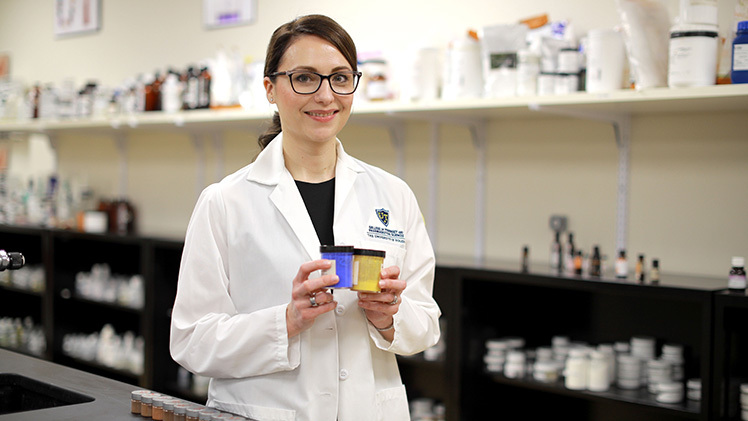Researchers at The University of Toledo have found that adding a vivid, deep blue pigment when making foundation can create warmer, more lifelike skin tones, particularly for dark skin.
Traditionally, foundation has been formulated from a mix of red, yellow, black and white colorants.

Research led by Dr. Gabriella Baki, an associate professor of pharmaceutics and director of UToledo’s undergraduate Cosmetic Science and Formulation Design program, has shown that a vivid deep blue pigment can help make more lifelike skin tones.
“Unfortunately, when it comes to creating foundations for dark skin colors, those combinations often produce more of a gray color than a natural brown skin color,” said Dr. Gabriella Baki, an associate professor of pharmaceutics and director of UToledo’s undergraduate Cosmetic Science and Formulation Design program. “It’s difficult to get a good, natural color when the foundation is rubbed out on the skin.”
Several years ago, a pair of Baki’s students came to her after listening to a podcast that mentioned ultramarine blue — a rich, deep blue pigment once derived from a gemstone and worth more than gold.
Why, they wondered, don’t we use it in foundation? It was already approved for use in cosmetics. Could it be the key to creating better, more visually appealing foundations for people with darker skin tones?
“If you ask any artist about color theory, they use primary colors — red, yellow, blue — to make all other shades,” Baki said. “Blue was missing from our equation.”
She and her students got to work, testing various formulations of red, yellow, blue, black along with pair of different white pigments, one of which is better at absorbing light and one better at reflecting it.
They found adding blue to the traditional mix could create more skin-like colors for both dark and light foundations.
The group first published their research in early 2024, focusing on loose powder foundations. Since then, they’ve successfully expanded concept to make stick foundations, creating a total of 22 loose powder foundations and 20 different stick foundations.
The colors have been tested visually on specialized paper and human skin as part of an approved clinical study and analyzed using high-tech spectrophotometry.
Baki will present the team’s findings at the spring meeting of the American Chemical Society on Wednesday, March 26, in San Diego.
While adding ultramarine blue in combination with black pigments can improve foundations across the color spectrum, the potential impact is greater for dark foundations.
“Your average foundation line might have 12 colors. Half of those are going to be for light skin tones. Then you have three for medium brown skin and three for dark brown skin,” said Baki, an expert in cosmetic design. “There just aren’t as many options for people with dark skin tones, and the products that are available often don’t produce true, skin-like colors. That’s where our findings can be transformative in the market.”
The idea of adding ultramarine blue to foundation sounds simple. And Baki says it is.
So why hasn’t it been done to a wide scale previously? UToledo researchers cite two main reasons.
The first is precedent. An industry cosmetic chemist is likely to stick with what they personally know and what they can find in the scientific literature. There was previously no data that showed it was helpful in foundations.
The second is smell. Ultramarine blue can give off a rotten egg smell in acidic environments — a concerning risk for a product you rub on your face. Because powder and stick foundations contain no water, that has not yet been an issue. UToledo scientists plan to investigate how that may factor in cream foundations as one of the next steps in their research.
The cost of synthetic ultramarine blue also is slightly more than black pigment, at about a quarter a pound. Though that could add up at scale, Baki said the potential benefits likely would outweigh the added cost.
Next up for the UToledo researchers is seeing if the earlier findings translate to cream foundations, which are much more commonly used by consumers than sticks or powders but is a more complex product to produce.
“That’s the big question we’re trying to answer right now. We started with simple products, got good results, and we’re now moving on to the more challenging products. That work is underway now,” Baki said. “We’re hoping to keep publishing and getting data to those who are out in the industry to show them this really works and it can help you create colors that you cannot create otherwise. We’re solving a problem that the industry hasn’t yet addressed.”